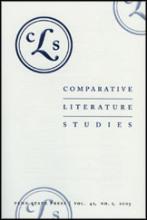This article is part of the special issue, "Beyond the Anglophone: Comparative South Asian Literatures," in Comparative Literature Studies. This issue focuses on the vernacular literatures of South Asia, which for the past three decades have been ignored and often overshadowed by South Asian literature in English. The eleven essays in this volume address the deficiencies and distortions marking global understandings of South Asian culture, and encourage some re-thinking on the core issue of India’s diverse and complex literary cultures.
Dubrow's article on the formation of the Urdu novel in colonial India argues that the novel emerged in South Asia not as an import from Europe, but rather as the product of multiple sources and as a genre capable of fulfilling a distinct function. The article argues that the novel as a genre arose in colonial India because of its ability to hold divergent points of view and to subtly critique the British government. It focuses on two early Urdu novels, Nazir Ahmad’s Mirāt ul-‘Arūs (1869) (The Bride’s Mirror) and Ratan Nath Sarshar’s Fasāna-e Āzād (1878–1883) (The Tale of Azad), to examine how novelists used techniques such as the contrasting character pair to explore irreconcilable problems under colonial rule. Fasāna-e Āzād drew from the earlier Indo-Persian and Urdu genre of the romance (dāstān) in its use of contrasting character pairs, reimagining the technique to carve out a space for debate and critique in the novel. This strategy represents one of the ways that early vernacular- language novelists fashioned the novel genre as a form uniquely suited to engaging with the challenges and contradictions of the colonial period.
